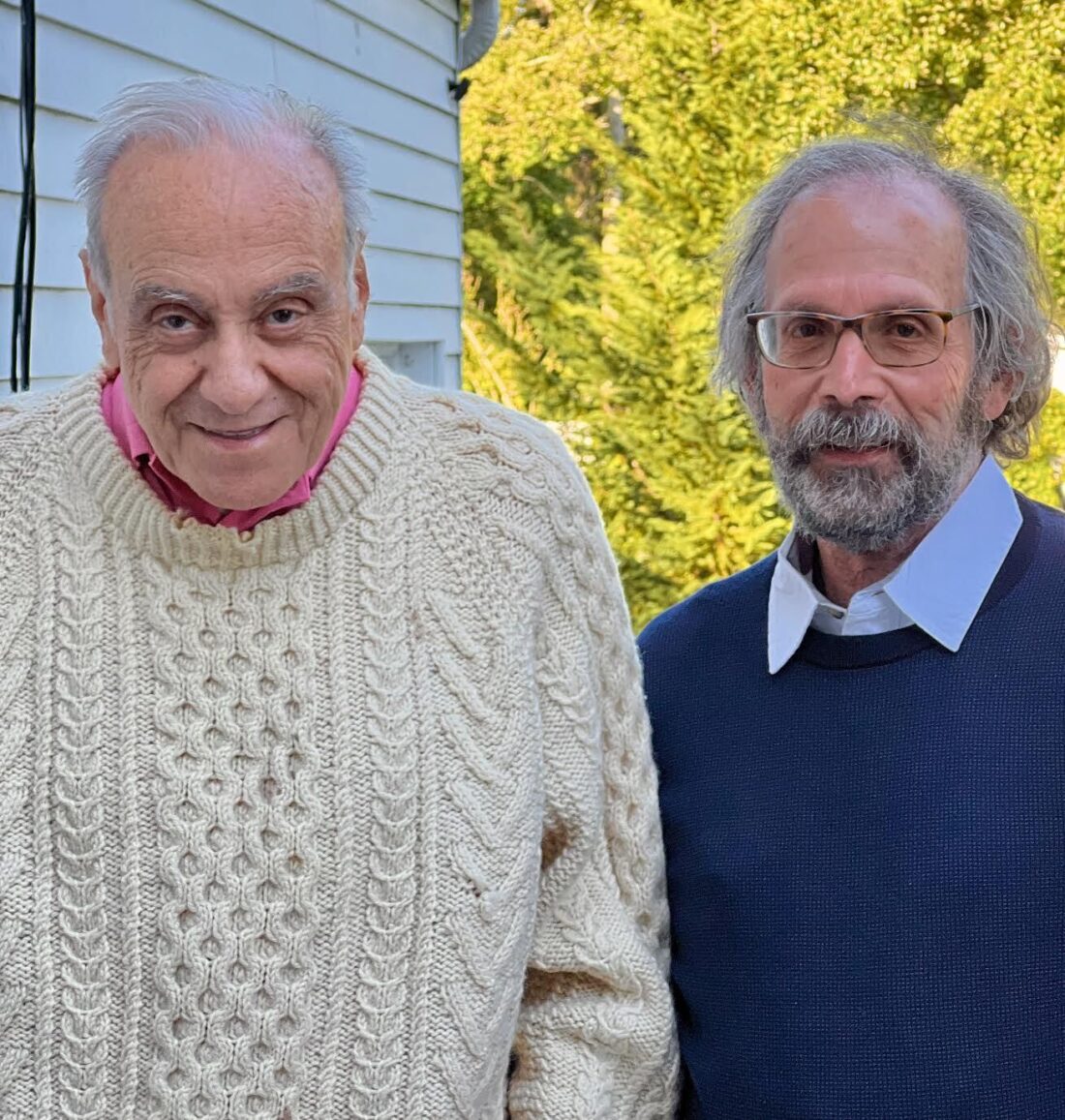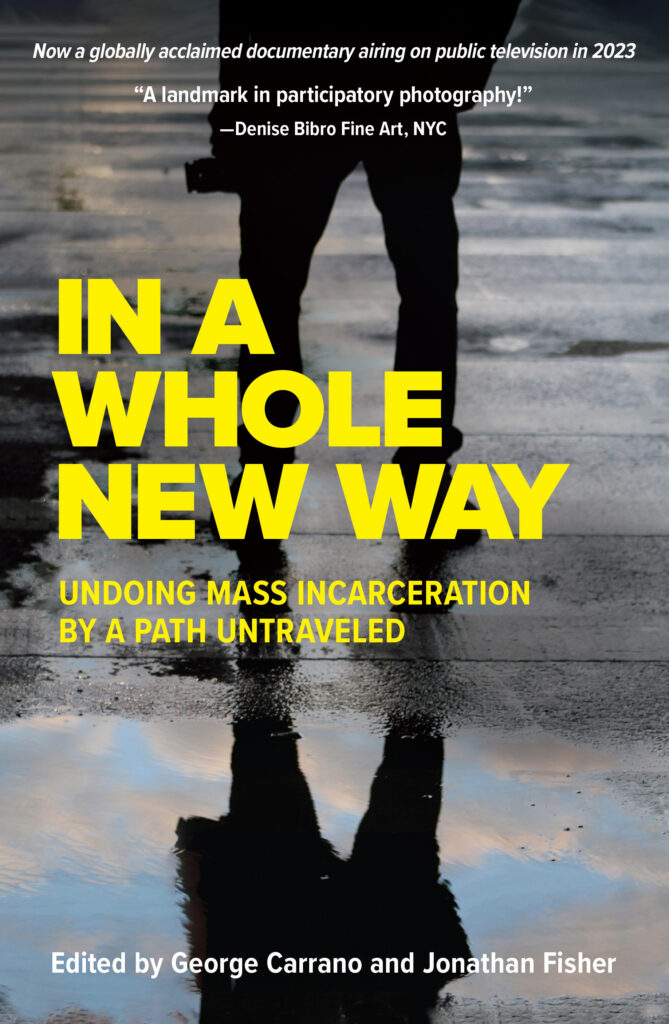
George Carrano & Jonathan Fisher
New York, NY, and Cape Elizabeth, ME
Authors and Award-Winning Documentary Filmmakers
BOOK COVER

BOOK DETAILS
Pub Date: June 20, 2023
Genre: Social Justice/Photography
Publisher: Prospecta Press
Page Count: 220
Format: Paperback, with photographs
ISBN: 978-1632261175
Price: $20.00
ABOUT THE BOOK
Undoing Incarceration by a Path Untraveled – Introducing Participatory Photography as a Transformative (Rehabilitative) Tool
If all Americans serving a term of probation were gathered in one locale, they would constitute the third-largest city in the country. Yet few of us understand what the sanction involves. Nor do many Americans realize that the originally rehabilitative practice became punitive following the 1972–92 crime wave. In many jurisdictions, it still is. Enter In a Whole New Way, a photographic self-portrait by New Yorkers who are serving a term of probation, being released in June in consort with a PBS documentary by the same name. The new book lifts the veil on this “second-chance” justice intervention that has spread from its origins in 1841 Boston to most of the world today.
In a Whole New Way shows how hundreds of determined city residents on probation, along with neighborhood allies, undertook to change the image of how probation has become a staging area for incarceration. Equipped with cameras and new artistic sensibilities provided by the editors’ nonprofit Seeing for Ourselves, they set off in a whole new way to reform the sanction, returning it to the rehabilitative and positive program it was originally intended to be. In the process, they found themselves transformed.
The result of their journey is this unique collection of stunning photographs, accentuated by
deeply personal captions and lengthier testimonies, that reveal the reality of life on probation. The stories of these participants powerfully undercut their own—and probation’s—derogatory popular image. The true goal of this book is to reform the entire justice system toward decarceration.
In a Whole New Way is both the sequel to the editors’ Project Lives (2015), the globally acclaimed volume resulting from a similar effort with New Yorkers living in public housing—a work catapulting Seeing for Ourselves to the front of “participatory photography” practitioners worldwide—and the source of today’s award-winning eponymous documentary film, airing on select public television stations in 2023.
ABOUT THE EDITORS
George Carrano grew up in the Bronx. He worked as a civil servant in New York City for 25 years before retiring to pursue his true passion, the visual arts. Carrano has subsequently devoted his time to equipping and training the marginalized to take back their public narrative through the mechanism of participatory photography—the basis for the nonprofit Seeing for Ourselves he founded in 2010. Project Lives was his first book and In a Whole New Way his first film.
Jonathan Fisher was also raised in the Bronx. He was one of those obnoxious brats pushing everyone out of the way on the subway trains so that he could look out the front window. After earning a master’s degree in transportation, Fisher pursued a childhood dream by working for the subway system for 26 years. He joined Seeing for Ourselves in 2013 as its storyteller. Project Lives was his first book. Writing and directing In a Whole New Way allowed him to cross another item off his bucket list.
TIMELY TIE-INS
November
- International Day of Tolerance – 16
- Restorative Justice Week – 19-25
PRAISE
“Institutional reforms often start from the outside and work inward, which is one reason why so many overpromise and underdeliver. In a Whole New Way shows us what it could look like when reform begins with the perspective of those on the inside of a system—in this case, individuals on probation in New York City. Using participatory photography as a means of visual storytelling, the participants in this transformative project narrate their view of the world through the lens of a camera. In so doing, they remind us that it’s often not people who need changing but the systems that envelope their lives and so frequently constrain their futures.”
—Steve Woolworth, Past President, International Community Justice Association
“A landmark in participatory photography!”
—Denise Bibro Fine Art, NYC
“The impact of second chances, unlike incarceration, cannot be measured by metrics alone. In a Whole New Way visually captures, on a human level, the challenges experienced by justice-impacted New Yorkers, illustrating that probation, like the criminal injustice system, needs reform.”
—Elizabeth Frederick, Chief Operating Officer, Avenues for Justice
“A wonderful contribution to our field. In a Whole New Way contains so much – it’s an engaging history of community corrections and a glimpse of how probation is practiced in New York City. It’s a series of memorable and moving vignettes about people whose lives have been touched by crime and the justice system. But what will stick with me are the pictures. Throughout the book, we see the faces of those who are participating in this unique and special program. They are smiling and engaged, clearly relishing the opportunity to see and be seen as so much more than the criminal convictions that brought them to probation in the first place. The light in their eyes – their positivity and evident optimism about their futures – is an overwhelming argument for the importance of meaningful second chances as a core component of our justice system.”
—Megan Quattlebaum, Director, The Council of State Governments Justice Center
Q&A
How does the book In a Whole New Way compare with your first work, Project Lives?
Project Lives was published in 2015 by powerHouse, a noted art book publisher. That meant it could be published in landscape orientation and hardcover on glossy paper, as originally intended. The photographs popped. Many reviewers cited the book’s beauty.
But publishing illustrated books became a much dicier proposition in the years following. Costs exploded while the market shrank. And then the pandemic disrupted supply chains, bringing publishing almost to a standstill. A perfect storm.
But changing the orientation to portrait mode and putting out the book in paperback, as Prospecta Press has elected, has its own advantages. In a Whole New Way is less likely than our first work to be taken as a coffee-table book. And it will be easier to sell the book at events like the annual conference of the community corrections industry.
What most surprised you in researching probation for this book?
The unheralded role of probation in effectively determining the sentences of so many of those convicted of crimes. Americans think it’s all up to the judge, but in so many cases they’re signing off on sentences recommended by the probation function.
How were the photos selected for the book?
They were overwhelmingly selected by the participants themselves. We had to fall back on a few alternatives where we did not have releases from a photographer with whom we had lost contact. As in our first initiative, those participating in our program are a somewhat transient population.
How would you like viewers to approach the photos?
While we would of course like the photos’ aesthetic value to be appreciated, we most of all would like viewers to say to themselves, “These are people just like me! Their lives are similar in many ways to my own.”
How does your nonprofit’s work with people on probation (and their neighbors) compare with your prior effort with housing project residents?
There are similarities but many more differences.
In each case, we sought to undo a scornful media portrayal over the last generation that had led to unfortunate consequences—defunding amid crime and disrepair, in the case of the projects; and keeping the practice from living up to its potential as an incarceration alternative, in the case of probation. In each case, the photographic output did create new imagery and place it before countless eyeballs. In each case, the participants focused on the positive aspects of their lives rather than broken toilets in the projects or probation check-ins.
But while in our first effort we equipped and trained youths and seniors, in our follow-up we served mostly young men. We attributed housing project photos by the full name of the photographer, but only by first name in the case of probation photos. Kodak disposable cameras were used in the housing project initiative, but—in keeping with their career aims—Sigma DSLRs in the probation project. The housing project participants were welcoming from the get-go, while considerable effort had to go into overcoming the suspicion of participants in the probation program. The housing project residents took one course and were gone, while we trained several students in the probation classes to become teachers in turn. The public housing initiative ended when we left the housing agency while the program became institutionalized at the probation department.
Did anyone accuse you of playing white saviors in the probation effort in particular?
No, and we turned that narrative on its head. While we provided the tools and training, the participants themselves did the heavy lifting of mastering a new skill to document their lives—and thereby help all Americans on probation, most of whom are white. We were delighted that the film won many Black Lives Matter awards, which seemed to prove our bona fides in this realm. We were also very pleased to have whites provide the comic relief in the film, flipping another practice on its head.
Has anyone at film festivals, conferences, or wherever else you screened the film pushed back at all?
No one, ever.
Can a documentary actually change the world, as you intend?
Birth of a Nation, to take a disgraceful example, surely did. And The Sorrow and the Pity transformed France’s national identity, to take a more positive example.
What’s your next project?
Equipping and training high-schoolers to picture their climate future. We’ve already begun doing this in Cape Elizabeth, Maine, and will be looking to expand to the South Shore of Long Island. We think such an age cohort has been marginalized in the national conversation about climate change.
What are your current plans for the film/book combination?
We are seeking to leverage PBS broadcasts, conference screenings, and publicity around the combination to persuade decision-makers to return probation to its rehabilitative roots nationally. And to then persuade them to offer it more widely as an alternative to locking people up.
BOOK DETAILS
Pub Date: February 7, 2023
Genre: Crime Mysteries / Suspense & Thriller
Publisher: Crooked Lane Books
Page Count: 272
Format: Hardcover, ebook
ISBN: 978-1-6391023-03
Price: $29.99



